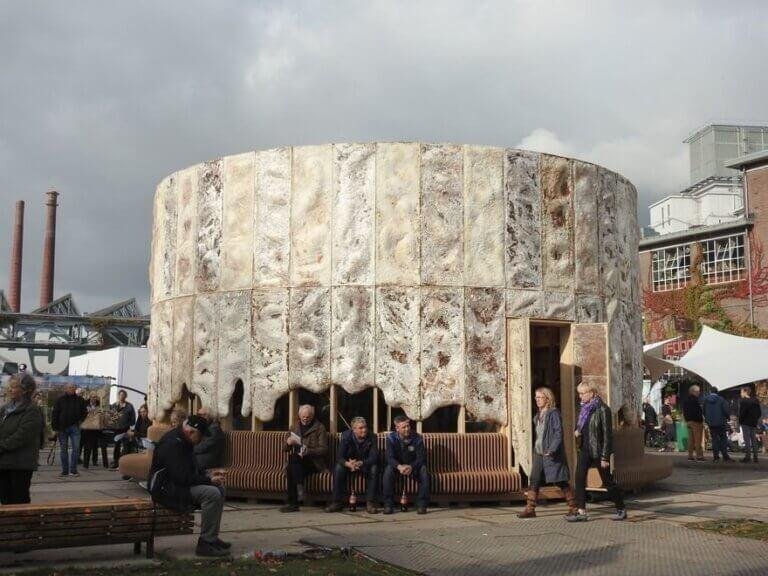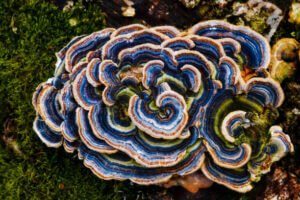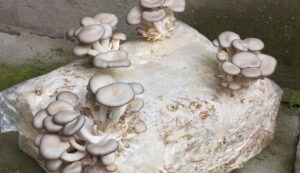In the vast tapestry of the natural world, there are organisms that hold the power to unlock the doors of perception, expand the boundaries of human consciousness, and connect us with the mysteries of the cosmos. Among these extraordinary entities, psilocybin mushrooms stand out as both a source of intrigue and an ancient companion to the human journey.
The history of psilocybin mushrooms is a fascinating and multifaceted story that weaves through cultures, civilizations, and time itself. From their use in shamanic rituals and spiritual practices to their encounters with science and legislation, these remarkable fungi have left an indelible mark on the human experience.
Join us as we embark on a journey through the annals of time to explore the origins, cultural significance, and enduring appeal of psilocybin mushrooms. We will trace their path from indigenous traditions to modern psychedelic renaissance, shedding light on the profound impact they have had on human history and our understanding of consciousness.
We will delve deep into the hidden corners of the past, uncovering the secrets of these mystical mushrooms and the role they have played in shaping our collective psyche. So, fasten your seatbelts and get ready for a trip through time as we unveil the captivating history of psilocybin mushrooms, from their ancient roots to their modern resurgence.
Psilocybin mushrooms in Prehistory
For example, one of the oldest representations of mushrooms was discovered in Africa in cave paintings at Tasili Algeria, These images are dated to between seven to nine thousand years old and depict several scenes involving mushrooms.


one image displays several figures holding up mushrooms in their right hands, and we can see parallel dotted lines connecting each mushroom to the top of the figure’s heads, possibly portraying the mushrooms as a source of knowledge, in another image a large, masked figure is shown with mushrooms growing from its hands forearms and thighs
Traveling over to Spain, the “Selva Pascuala” mural provides some of the earliest evidence of psychedelic mushroom use in Europe. This image was created about 6,000 years ago, and we can see what appears to be a row of mushrooms painted onto the rock, which may indicate that these mushrooms were honored and regarded as extremely important.

In Australia, we find even older depictions of mushrooms and mushroom-like figures, at the Bradshaw Rock Art, dated to 10,000 BCE, which is more than twice the age of Stonehenge, and here we can see what appear to be several figures with mushroom-shaped heads.
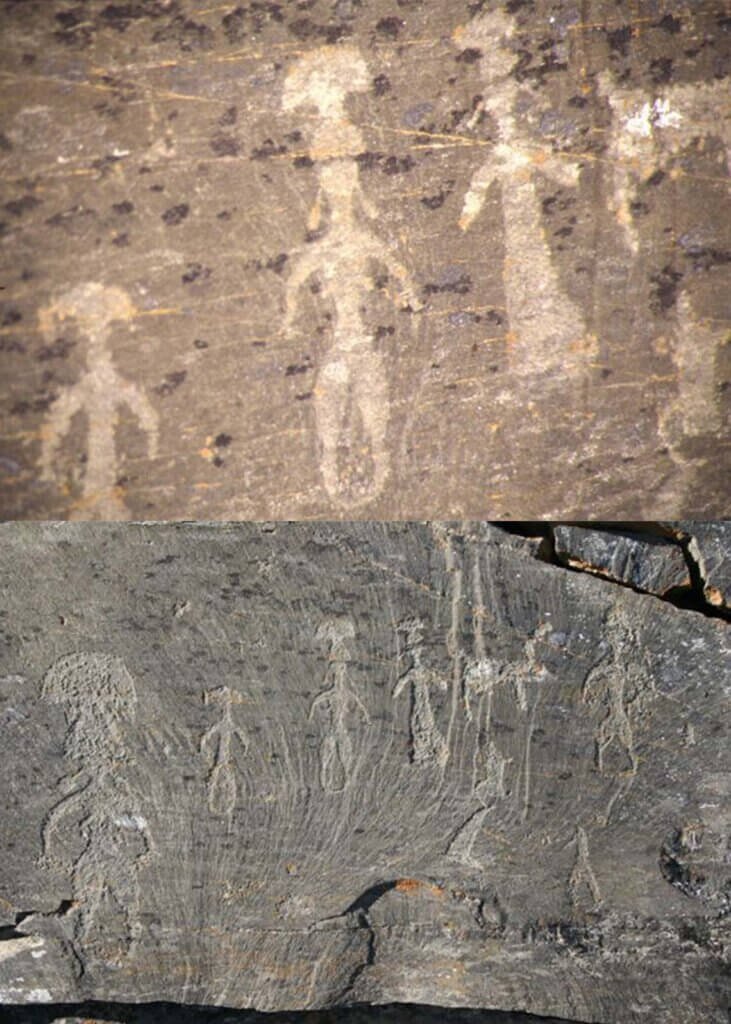
Traveling over to Siberia, a region that’s home to the Amanita muscaria mushroom, we find the Pegtymel petroglyphs, estimated to be around 3000 years old, where once again we can see several figures with mushroom-shaped heads, which are similar in shape to the Bradshaw Rock Art, all the way over in Australia, and it’s interesting to note some of these similarities in the mushroom iconography from all over the world.

Psilocybin mushrooms in Central America
Psilocybin mushrooms have a long history of use in Central America, particularly among indigenous cultures. Although the exact origins of their use are unknown, evidence suggests that psilocybin mushrooms have been used for thousands of years.
One of the earliest pieces of evidence of psilocybin mushroom use in Central America comes from archaeological findings in Guatemala. In 1996, a group of archaeologists discovered a mural in the ancient Mayan city of Bonampak, dating back to around 750 AD. The mural, known as the “Mushroom Stone,” depicts a ritual scene in which mushroom-headed figures participate in a ceremony, suggesting the significance of psilocybin mushrooms in Mayan culture.


Ethnographic studies conducted in the early 20th century also shed light on the traditional use of psilocybin mushrooms in Central America. For example, the Mazatec people of Mexico have a history of using psilocybin mushrooms in their spiritual practices. Scholar and ethnomycologist R. Gordon Wasson conducted extensive research on the Mazatec people in the 1950s and documented their use of psychedelic mushrooms, which they called “teonanácatl,” meaning “flesh of the gods.”
The Mazatec shamans would consume psilocybin mushrooms as a means of connecting with the divine and gaining spiritual insight. These mushroom ceremonies were often conducted in a controlled environment and involved rituals and chanting.
Psilocybin mushrooms in ancient Egypt and the Middle East

Ancient Egypt used to be called Kamet. From this word kamet, we get the word alchemy.
The ancient Egyptians were very advanced in all ways, including mathematics, monumental architecture, advanced agriculture, complex religious beliefs, art, and medicine, with a profound knowledge of the plant world. utilizing some of these plants, like opium or the blue water lotus, to invoke shamanic vision.
This is the temple of Hathor, the cow goddess of fertility and love. The inner chambers of this temple were reserved only for priests and royalty, and here carved on the walls are mushrooms amongst other plants like the lotus.
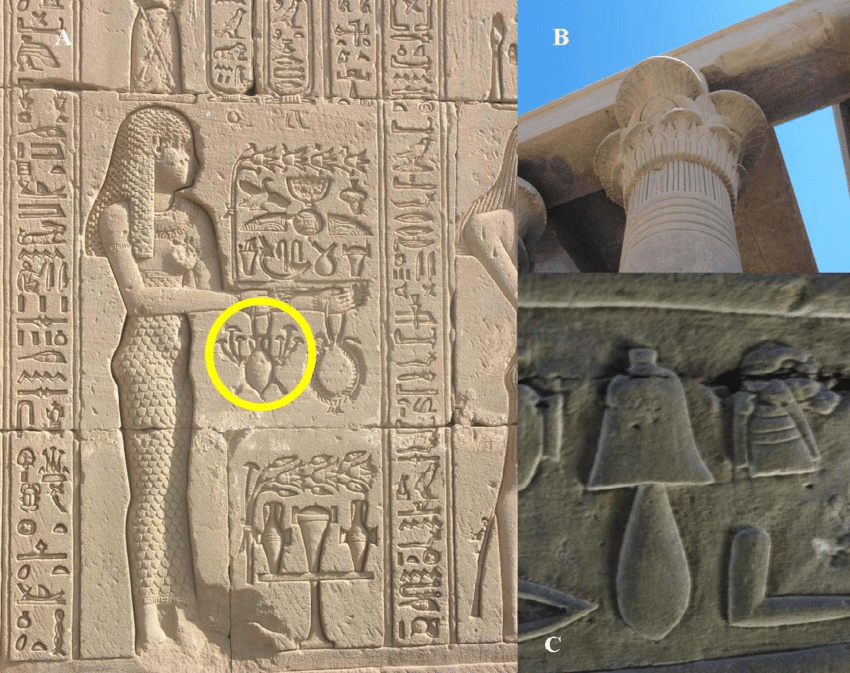
According to a few sources, there is some evidence that ancient Egyptians used psilocybin mushrooms for religious purposes. Stephen R. Berlant, a physiological psychologist and Egyptologist, has argued that Psilocybe mushrooms, alongside other psychotropic plants like the Nymphaea alba lotus, played an important role in Egyptian religion and myth, and that experiences with the hallucinogenic properties of these mushrooms even influenced the Pharaohs belief in their own immortality. Because of how special they were, they were only consumed for religious reasons by priests and by the upper class.
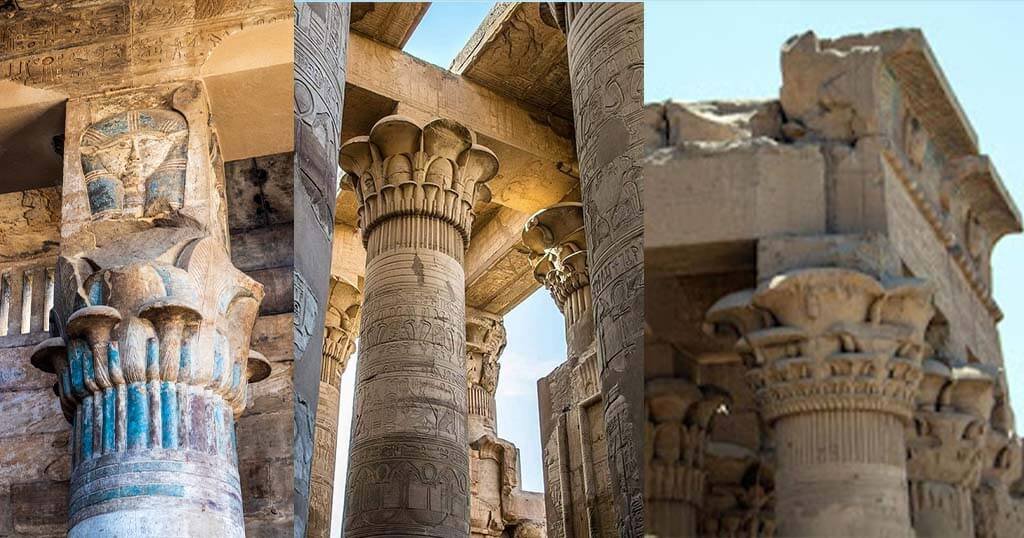
There are also some ancient Egyptian artworks that depict mushrooms, such as the pectoral amulet found in the tomb of King Tutankhamun, which shows the Eye of Horus surrounded by mushroom-like shapes. Additionally, in the Egyptian Book of the Dead, mushrooms are referred to as “the food of the gods”, “celestial food”, and “flesh of the gods” were placed on the earth by the god Osiris. Because of how special they were, they were only consumed for religious reasons by priests and by the upper class. However, it is important to note that there is no concrete evidence to support this claim, and it remains a topic of debate among scholars.
Psilocybin mushrooms in Greece

direct evidence of their use in ancient Greece is limited, and much of the knowledge we have comes from the writings of historians and philosophers.
In ancient Greece, certain fungi were considered sacred and were associated with religious and mystical practices. However, it is important to note that the specific species of mushrooms containing psilocybin, which produce psychoactive effects, are not native to Greece. These mushrooms are typically found in subtropical and tropical regions, such as Central and South America.
Literary References: Ancient Greek literature often contains descriptions of altered states of consciousness or visions, which could possibly be linked to the use of psychoactive substances. For example, in “The Odyssey” by Homer, the character Circe is depicted as using herbs to transform Odysseus‘ companions into animals, indicating the potential use of hallucinogens.
One of the most well-known Greek philosophers, Plato, mentions the use of “sacred fungi” in his writings. In his dialogue “Phaedrus,” Plato discusses the concept of insanity caused by “misuse of certain mystic rites.” While he does not explicitly mention mushrooms, this has been interpreted by some scholars as a reference to the use of hallucinogenic substances like magic mushrooms.
Another mention of psychoactive substances in ancient Greek culture comes from the poet and playwright Euripides. In his play “The Bacchae,” he describes the behavior of the followers of Dionysus, the god of wine and ecstasy. These followers, known as maenads, engage in ecstatic rituals involving wine and intoxicating plants. Although magic mushrooms are not specifically mentioned, some have speculated that these plants could have included psychoactive fungi.
Minoan Civilization: The Minoan civilization flourished on the island of Crete from approximately 2700 to 1450 BCE. Archaeological findings at the Minoan site of Knossos, such as frescoes and sculptures, depict various plants and mushrooms, some of which are known to have psychoactive properties. While the exact purpose or use of these mushrooms is uncertain, their presence suggests some level of significance in religious or cultural practices.

Dionysian Mysteries: The Eleusinian Mysteries were psychedelic rituals that were not just accepted by the ancient Greek society but celebrated by it. The festival was held annually in the town of Eleusis, near Athens, and was open to all Greek-speaking people. The festival was a celebration of the goddess Demeter and her daughter Persephone, who was abducted by Hades, the god of the underworld. The festival was divided into two parts: the Lesser Mysteries and the Greater Mysteries. The Lesser Mysteries were held in the spring, while the Greater Mysteries were held in September.
The Greater Mysteries were a nine-day event that culminated in a psychedelic experience. The participants drank a potion called kykeon, which contained ergot, a fungus that grows on rye and wheat and contains lysergic acid, a precursor to LSD. The potion also contained other psychoactive ingredients, including possibly psilocybin mushrooms. The participants then entered a darkened hall called the Telesterion, where they experienced a vision of the afterlife.

Aristotle was born after the decline of the Eleusinian Mysteries, so there is no direct evidence that he used magic mushrooms. However, Aristotle did write about altered states of consciousness and their effects on human behavior. He believed that altered states of consciousness could lead to greater understanding of oneself and the world around them.
Psilocybin mushrooms in Ancient Siberia
Indigenous peoples in the region have utilized these mushrooms for various purposes, including spiritual and religious rituals, divination, and healing practices.
The earliest evidence of psilocybin mushroom use in Siberia comes from the archaeological site of Turganik, located in the Altai Mountains. Excavations at this site have revealed the presence of rock art depicting mushrooms, dating back around 4,000-6,000 years. These rock art images indicate that psychedelic mushrooms held significant cultural and spiritual importance for the ancient Siberians.

Psilocybin mushrooms were often consumed during shamanic practices in ancient Siberia. Shamanism played a central role in the spiritual beliefs of these indigenous communities. Shamanistic rituals involved the shaman ingesting mushrooms to induce altered states of consciousness in order to communicate with spirits, gain insights, and perform healings.
The ancient Siberians believed that these mushrooms possessed supernatural powers and were a means of journeying between the human and spirit realms. The altered state of consciousness induced by psilocybin mushrooms was seen as a way to connect with the spiritual world and gain spiritual wisdom. Shamans also used these mushrooms to diagnose and treat illnesses.
Furthermore, psilocybin mushrooms were used in divination practices. The experience of consuming mushrooms was believed to provide insights and visions about the future or answers to specific questions. Ancient Siberians sought guidance and knowledge by ingesting these mushrooms as a means of divination.

The knowledge and practices surrounding psilocybin mushrooms were passed down through generations within these indigenous communities. However, with the arrival of Christianity and subsequent persecution of shamanism, the use of psychedelic mushrooms and other traditional practices were suppressed and almost forgotten for centuries.
History of psilocybin mushrooms in modern times
The knowledge of these mushrooms began to resurface in the 20th century. The most notable figure in this rediscovery was R. Gordon Wasson, an American banker and amateur ethnomycologist. In 1955, Wasson and his wife, Valentina Pavlovna, participated in a Mazatec mushroom ceremony in Mexico, an experience that was documented in Life Magazine. This event brought attention to the existence and potential of psilocybin mushrooms in the Western world.
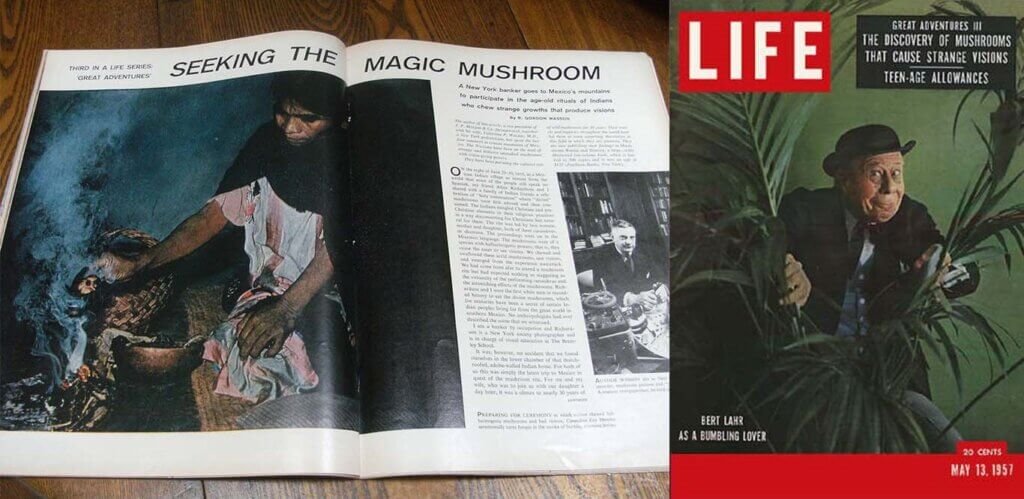
In the mid-20th century, psilocybin mushrooms found themselves at the heart of the counterculture movement that emerged in the United States. This period, often associated with the 1960s and 1970s, was marked by a rejection of traditional values and a quest for personal and societal transformation.
Many individuals, including prominent figures like Timothy Leary, advocated for the use of psilocybin and other psychedelics as tools for expanding consciousness, achieving self-discovery, and challenging societal norms. They believed that these substances had the potential to bridge the gap between generations, promote peace, and counter the prevailing militaristic and conformist culture.


The Vietnam War’s Influence
The Vietnam War, which raged on from the mid-1950s to the mid-1970s, played a significant role in shaping the era. This war had a profound impact on American society, contributing to widespread disillusionment, protest, and a desire for alternative perspectives.
The Vietnam War, which raged on from the mid-1950s to the mid-1970s, played a significant role in shaping the era. This war had a profound impact on American society, contributing to widespread disillusionment, protest, and a desire for alternative perspectives.
Many individuals who opposed the war turned to substances like psilocybin mushrooms as a means of coping with the emotional and psychological toll of the conflict. The war’s brutality and the stark contrast between the government’s official narrative and the realities of the battlefield fueled a sense of mistrust and the search for new avenues of understanding.
Psilocybin as a Tool for Dissent and Self-Exploration
Psilocybin mushrooms became a symbol of resistance to the Vietnam War and the establishment. They were seen as a way to challenge the status quo and promote peace and understanding. The counterculture movement, fueled by a desire for change and an alternative perspective, embraced the use of these substances.
This period saw the growth of a vibrant subculture that used psilocybin and other psychedelics in communal settings, often leading to deep introspection and a sense of interconnectedness. It also saw an increase in scientific research into the potential therapeutic benefits of these substances.

Legal Crackdown and the End of an Era
As the counterculture movement waned and the Nixon administration’s “War on Drugs” policies took hold in the early 1970s, psilocybin mushrooms faced increasing legal restrictions. They were classified as Schedule I substances, making their possession and use illegal in the United States. This crackdown marked the end of the era of widespread exploration of psychedelics, including psilocybin.
The history of psilocybin mushrooms in modern times and during the Vietnam War is a story of cultural rebellion, consciousness exploration, and the interplay between the counterculture and the events of the time. These mushrooms became emblematic of the era’s search for alternatives to the prevailing norms and the desire for a more peaceful and enlightened world.
Conclusion
It’s safe to say that psychedelic mushrooms have been consumed for many thousands of years as tools for healing and transformation. As a result, it’s likely that these psychedelic mushrooms have played a significant role in our collective social and cultural evolution as a species.
In fact, the famous researcher and psychonaut Terence Mckenna theorized in his stoned ape theory that hundreds of thousands of years ago, psychedelic mushrooms may have served as a catalyst for the development of the human brain and higher cognitive functions.
And whether or not that’s true, this has been a core part of the human experience for many thousands of years; this is part of our collective inheritance, and it really invites reflection on the question of why psilocybin mushrooms are illegal in most modern societies across the globe.
And as we look towards the future of psilocybin and psychedelic-assisted therapies, especially at this juncture, at this point in human history, it seems more important than ever that we continue to reflect on our past on our ancient roots and learn from the wisdom of our ancestors.



